Calabrian Easter Bread
This Easter Bread is a traditional Calabrian recipe, make it the Italian way by adding eggs or a sweeter way by adding sprinkles. It is the ultimate no yeast breakfast bread, serve with a cappuccino or caffe latte and start dunking! This Traditional Italian Easter Bread is a must make!
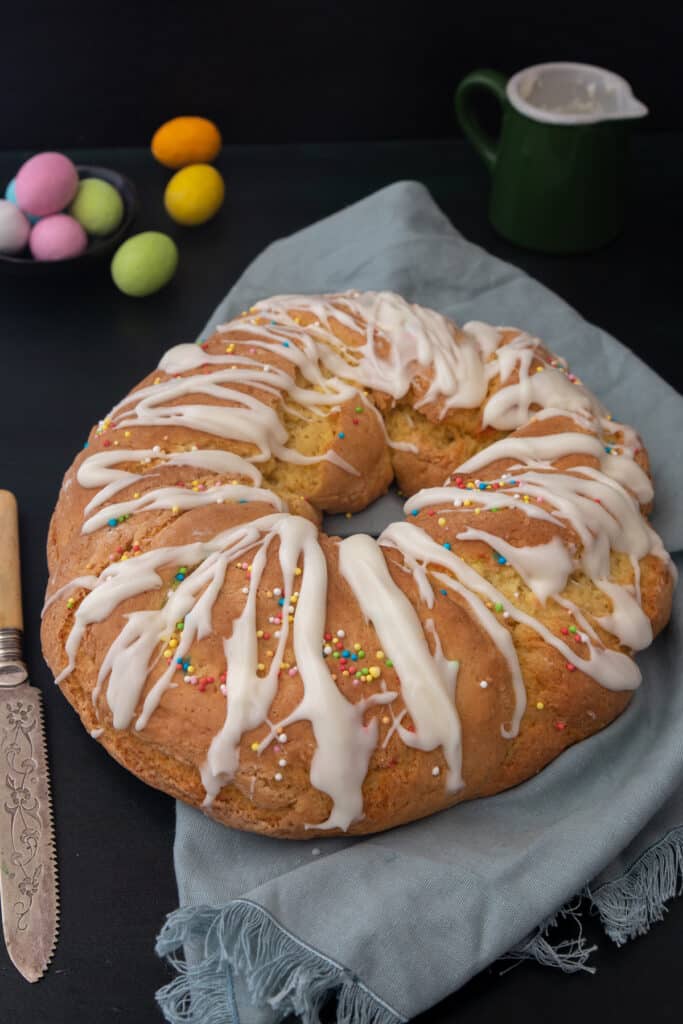
Since the age of nine this Italian Easter Bread made me appreciate even more Easter foods, from a Traditional Yeast Bread to Italian Easter Cookies to even a tasty Colomba, although an Easter Scarcelle Pugliese is always worth a try! Although, I am not the only one in my family who married an Italian. My oldest sister started it!
She had a mother-in-law who could cook too. How many times did I go over to her house and when I was asked if I had eaten I would naturally answer that I hadn’t just so I would get an amazing bowl of pasta.
Mamma Jen, as she was affectionately called, seemed to be always in the kitchen stirring up some delicious dish one after the another. The first time my sister arrived bearing this delicious Italian Easter Bread I was sold.
Unfortunately things change, we grow up, people leave us and I received no more Italian Easter Bread. Lucky for me I was still in contact with Mamma Jen’s granddaughter and she so kindly sent me the recipe.
Recipe Ingredients
- Flour – all purpose flour or bread flour, at least 11% protein
- Baking powder –
- Salt
- Eggs – room temperature large eggs
- Sugar – granulated sugar
- Milk – room temperature 2% or whole milk
- Vegetable oil – I use corn or sunflower oil you could also use a light olive oil if you wish

Vanilla Glaze
- Powdered sugar –
- Milk – or cream (any type)
- Vanilla – vanilla extract
Why use room temperature ingredients?
With cakes and other baking, it’s always better to use room temperature ingredients. So, take any cold ingredients out of the refrigerator an hour ahead of time or sooner if it’s cool in your kitchen. Room temperature ingredients blend easier, which will help to create a more tender baked good.
What is the origin of this Easter Bread?
She also informed me that this delicious cake is actually known as Cuculi, it is an Easter Bread typical to Calabria. I remember that eggs were baked into this cake ring, but since my family is not the hard-boiled egg type I make it without and I sprinkle with nonpareils also known as 100’s and 1000’s.

How to make Easter Bread
I made a little change to the recipe. I always remember this bread being very dry, so to give it a bit of moisture, although it is supposed to be on the dryer side since it is considered a dunking bread. Instead of 6 whole eggs you use 4 whole eggs and 2 egg yolks. I actually halved the recipe so I used 2 whole eggs and 1 egg yolk.
In a medium bowl whisk together the flour, baking powder and salt.
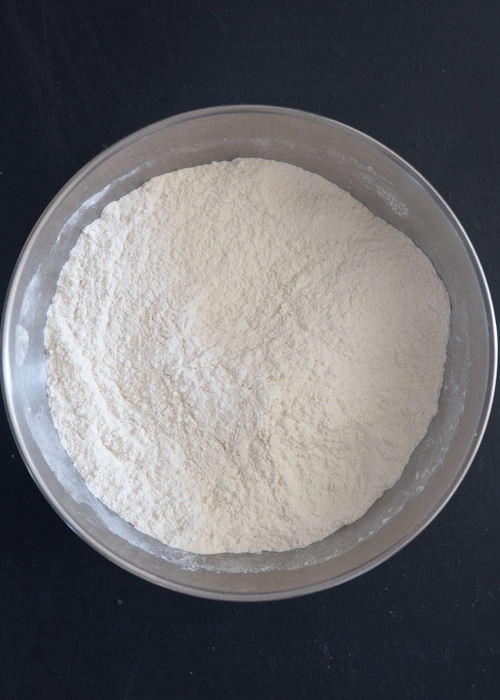
In a large bowl beat the eggs and sugar together, add the milk and combine, then add the vegetable oil and beat to combine. This can also be made in a stand mixer using the flat beaters.
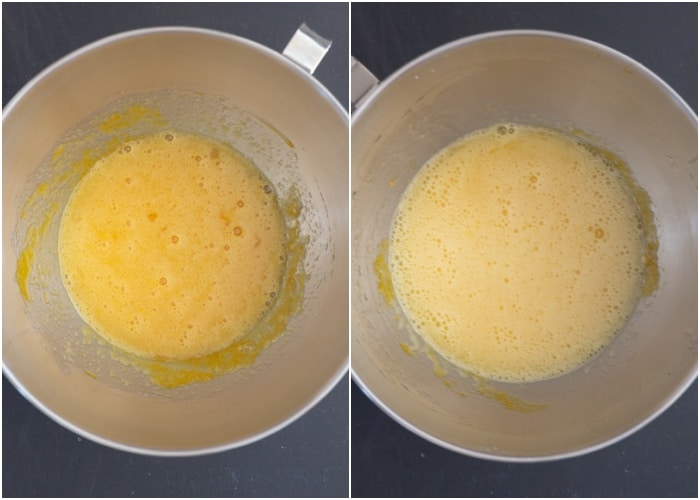
Add the flour mixture to wet mixture, combine on low speed then increase to combine well.
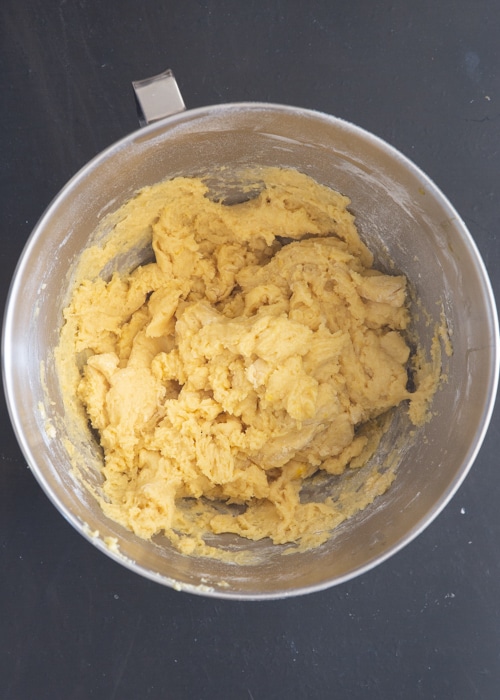
Move the dough to a lightly floured flat surface and gently knead a couple of times to make a dough ball.
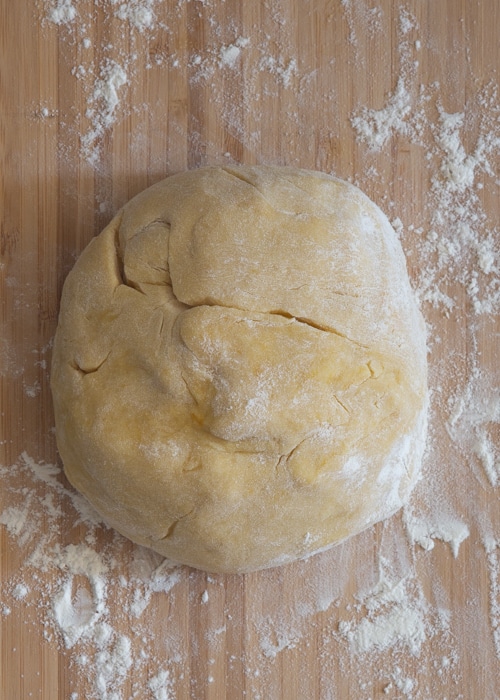
If you use a hand beater, the dough may be too stiff to beat, in that case add 3/4 of the dry ingredients and combine with a wooden spoon. Then move the dough mixture to a flat surface add the remaining flour and gently knead to form a smooth compact dough.
Shape the dough into the desired dough forms, such as a loaf or a braid.
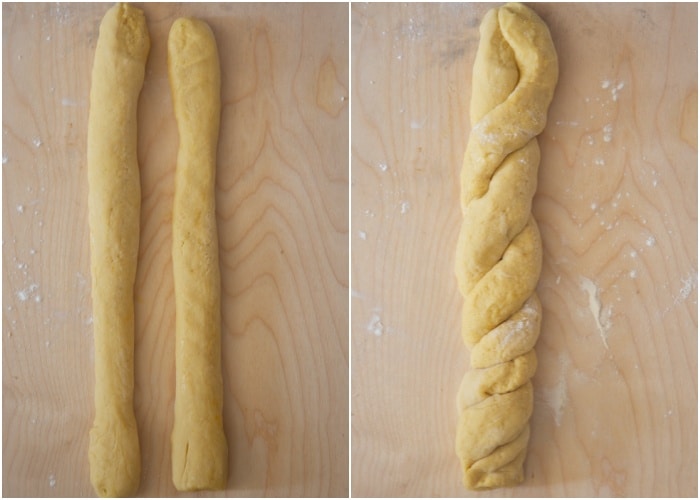
Place the dough on a parchment-lined baking sheet and bake until lightly golden brown, or until a toothpick comes out dry or with a few crumbs attached.

Cool five minutes on the baking sheet then move to a wire rack to cool completely. Cool completely before drizzling with glaze.
If you wish to add hard boiled eggs, then either use raw dyed or non dyed eggs, carefully place firmly in the dough before baking. If you use eggs rather than sprinkles, then brush the dough with either an egg wash or a little milk before baking. Don’t brush anything on the eggs.
Can this Recipe be halved?
If this recipe is too large for you then yes the recipe can be halved.
Is Easter Bread moist?
This Italian Easter Bread or Cuculi is a typical Italian Bread/Cake that is not too sweet, so an icing sugar glaze is the perfect topping and it is on the drier side this is not one of those moist breads.
This is why it makes the perfect dunking bread / cake with an afternoon tea or coffee. As the Italian says “the perfect dipping sweet bread”.
How to make a bread braid
Roll the dough into two long ropes, pinch the ropes together at one end. Then, begin braiding by crossing the one rope over the other rope, continue until the braid is done. Pinch the end together, then bring the ends together to form a circle.
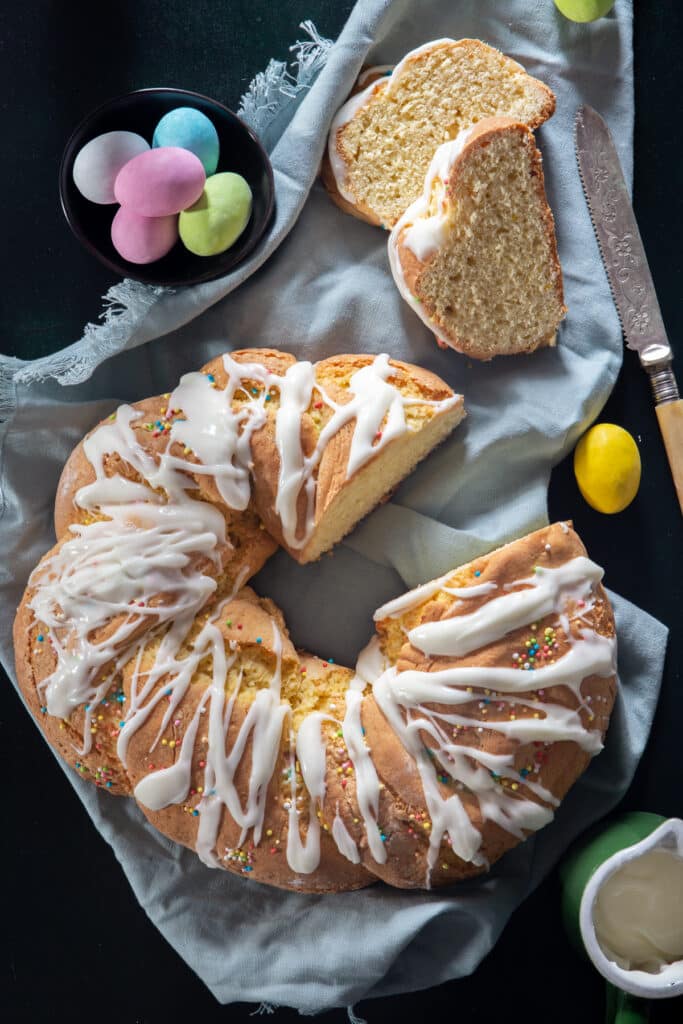
How to add eggs to the bread
If you do wish to add eggs to your bread, then you can either use dyed or non dyed Raw eggs. Just place them gently but firmly in the dough before baking. The eggs will cook while baking.
How to add the sprinkles or nonpareils before baking
The best way to add them is lightly pressing the sprinkles also known as jimmies or nonpareils onto the top of the cookie dough. This way they won’t roll off the dough.
It’s not a good idea to brush the dough with an egg wash or milk and sprinkle them on, because when baked they will melt into the cookie, and it won’t look too pretty.
When to serve the Calabrese Easter Bread
This is the type of bread that can be served at breakfast, at an Easter brunch, for a snack or even after dinner with a cup of tea, coffee or even a glass of wine.
How to Store Italian Easter Bread
This Easter Bread once baked should be stored in an airtight container and will keep from 7-10 days. If you like you can always slice it then and toast it. A delicious Breakfast idea.
How to freeze it
Wrap the completely cooled bread well in foil then place in a freezer bag, you can also wrap individual slices if you prefer. Then place in the freezer. It will keep for up to 3 months in the freezer.
So if you are looking for a delicious Italian Easter recipe then I think this Calabrese Easter Bread is just the thing. Happy Easter and enjoy!
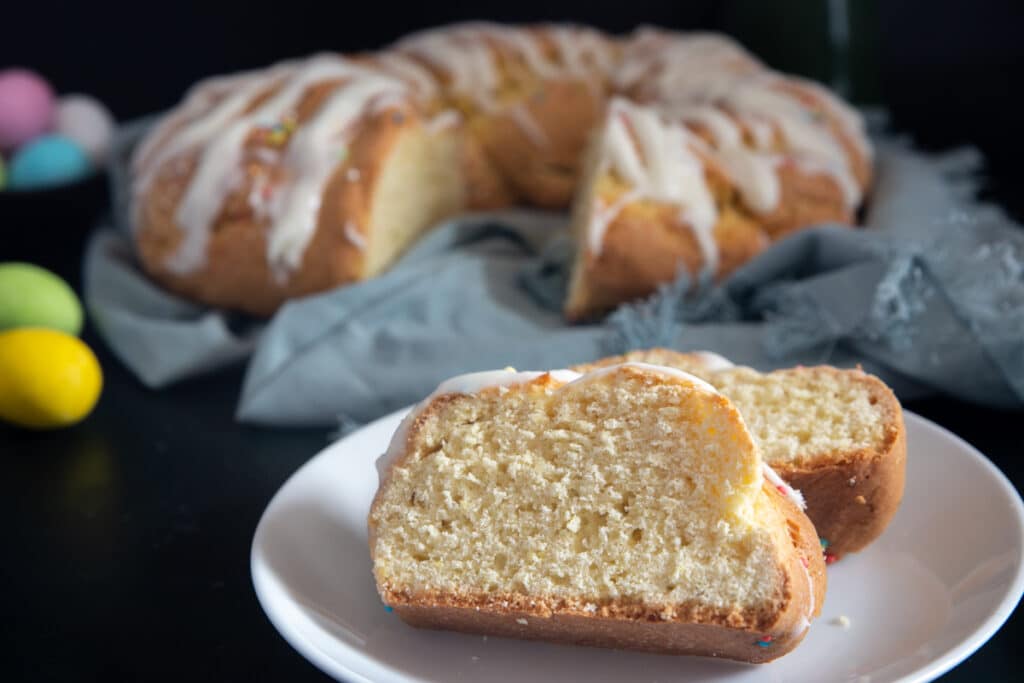

Calabrese Easter Bread
Ingredients
BREAD DOUGH
- 7½ cups all purpose flour
- 6 teaspoons baking powder
- ¼ teaspoon salt
- 6 large eggs (room temperature)
- 1½ cups granulated sugar
- 1 cup milk 2% or whole milk (room temperature)
- 6 tablespoons vegetable oil
VANILLA GLAZE
- 1½ cups powdered/icing sugar
- 3-4 tablespoons milk (2% or whole milk) (more or less depending on desired thickness)
- 1 teaspoon vanilla extract
Instructions
- Pre-heat oven to 350F (180C). Line a large baking sheet with parchment paper.
- I made a little change to the recipe. I always remember this bread being very dry, so to give it a bit of moisture, although it is supposed to be on the dryer side since it is considered a dunking bread. Instead of 6 whole eggs, use 4 whole eggs and 2 egg yolks. I actually halved the recipe so I used 2 whole eggs and 1 egg yolk. You will also have to increase the flour by 2-4 tablespoons.
BREAD DOUGH
- In a medium bowl whisk together the flour, baking powder and salt.
- In a large bowl beat the eggs and sugar together, add the milk and combine, then add the vegetable oil and beat to combine. This can also be made in a stand mixer using the flat beaters.
- Add the flour mixture to wet mixture, combine on low speed then increase to speed #2 to combine well.
- Move the dough to a lightly floured flat surface and gently knead a couple of times to make a dough ball.
- If you use a hand beater, the dough may be too stiff to beat, in that case add 3/4 of the dry ingredients and combine with a wooden spoon. Then move the dough mixture to a flat surface add the remaining flour and gently knead to form a smooth compact dough.
- Shape the dough into the desired dough forms, such as a loaf or a braid. Place the dough on a parchment-lined baking sheet and bake for approximately 40-60 minutes, until lightly golden brown, or until a toothpick comes out dry or with a few crumbs attached. If you find it browning too much and it isn't yet baked, then place a piece of foil over the bread (like a tent) and continue baking.
- Cool five minutes on the baking sheet then move to a wire rack to cool completely. Cool completely before drizzling with the glaze.
VANILLA GLAZE
- In a medium bowl whisk together the powdered sugar and vanilla then slowly whisk in the milk, stirring continuously to make a smooth glaze. Pour over cooled cake.
If you wish to add hard boiled eggs, then either use raw dyed or non dyed eggs, carefully place firmly in the dough before baking. If you use eggs rather than sprinkles, then brush the dough with either an egg wash (1 egg beaten with 1 tablespoon of water) or a little milk before baking. Don’t brush anything on the eggs.
Notes
Nutrition
Recipe updated from March 29, 2015.
Referring to the traditional hard boil eggs added on, Do we hard boil our added eggs before or do they hard boil when cooked?
Thanks.
Hi Sue, they will cook while baking so no need to hard boil before. 🙂
My insticts told me that SIX teaspoons of baking powder would be way too much and I was right. This bread rose so much that it cracked all over the place.
Hi Pam, no it isn’t too much for 7 1/2 cups of flour. 🙂
I was surprised to not see any particular flavoring added, like Orange, Lemon, Cinnamon or even Anise. Is that typically the way it is done, as just a bread? Thank you!
Hi Gianni I think you commented on the wrong bread. The Roman Easter bread is the one with the cinnamon or even anise, and yes typically cinnamon is added with the lemon and orange and you can add anise instead of cinnamon or half half if you want. I make it very simple just the orange and lemon and we really like it. Hope that helps. Take care!
There is no orange or lemon listed in this recipe.
Hi Gay, this bread was made without, if you want to add it you can. One to two tablespoons of zest should be enough. Take care!
I would like to make individual round rolls with this recipe What would be the bake time?
Hi Elaine, I would start to check them at around 15 minutes, they will probably need more depending on the size. If they start to brown too much before being baked then place a piece of foil over them and continue baking. Let me know how it goes. Take care and have a great weekend.
I have lost all of my recipes from my family which are Italian my grandmother was Cecilia my grandfather was Napoleon and my grandmother always made this bread I did make it today and it takes exactly like my grandmother and my mother used to make God bless you and thank you so much for this recipe I will be making it a lot
Hi Betty, thanks so much so glad I could help. I actually just redid this recipe with new photos last weekend. And it’s still one of my favourites. God bless you too! Take care.
We LOVED this! I halved the recipe and it worked perfectly to make one large wreath for our Easter dinner table. This recipe is identical to my nonna’s – with the minor exception that instead of the baking powder, she used the bertolini packets of baking powder with vanillin added in. I am living outside of the country now and cannot find the bertolini packets, so in order to replicate that flavour, I substituted one pkg of vanilla sugar (8 grams) for 8 grams of the regular sugar. I also used olive oil instead of vegetable oil. This is indeed a dry biscuit/cake type dough -similar to an S cookie perhaps – but it is absolutely wonderful for dipping into milk or coffee or tea or whatever you choose! My young kids (now 4 and 7) absolutely love this recipe – and they like helping to make it too 🙂
Hi Vittoria, thanks so much, so glad I could bring back memories. And good idea with the vanilla sugar. Take care.
This Easter bread looks so much easier than what I usually make. (With yeast and fresh orange juice…just a ton of steps, and evey once in a while it just doesn’t turn out correctly). I’m so excited to make this version! Thanks!
Thanks Rena, let me know how it goes.
The recipe calls for CAKE DOUGH but it isn’t a link and I cannot find it on your site. I would really like to make this recipe.
Hi Ste, cake dough is the sub title with the ingredients and directions listed underneath. Hope that helps.
Your recipe is the same as my grandmother’s and I just made it this morning. It turned out so delicious. My gradmother was Napolitan and she made it every year! I didn’t have her exact recipe but remember her using evaporated milk. I added some lemon zest to the batter also. Thanks for publishing this.
Hi Roseann, so glad you liked it and have a wonderful Easter.
My friend told me it was dry…Not sure if this is normal
Hi Kathy, actually Italian sweet breads and sponge cakes do tend to be on the drier side because they contain less fats. I guess that is why they go great with a cup of tea or coffee. Happy Easter!
We are going to give it a try tomorrow wish me luck
Good luck, let me know how it goes! Happy Easter.
I was wondering why this Easter bread has no yeast
Hi Jeanne, because this more a typical bread/cake so therefore no yeast. It is on the dry side but I love it.
thank you for the recipe can I bake the bread in a loaf pan thank you
Hi yes that should be no problem, although it does make enough for 3 loaves. Hope that helps. Let me know how it goes.
Looks amazing! Going to give it a try for Easter…my family is going to love this!
Hi Veronica, thanks you hope you like it.
We are from Calabria and this Cuculi is our traditional sweet Easter bread. So fun to see it on your website! Thank you!
Hi Julie, thanks, I love that bread.
Rose,
I just love reading about you, your family, your memories and your life.
Thank you for this recipe. You take such good photos!
My kids won’t eat hard-boiled eggs, either, so I will leave them out, even though they make it look even prettier.
Hi Barbara, thanks so much, hope you enjoy it.
My family is from Calabria, and they made Easter bread with the colored eggs as well. Although I don’t remember it being a sweet dough, or having icing. It was more like regular Italian bread, but I do remember it was made with lard. Unfortunately, nobody thought to write down Nonna’s recipes until after she passed away! Sad that she took so many wonderful family recipes with her. But, I thank you, Rose for bringing back some wonderful memories of our Italian Easter celebrations. Buona Pasqua!